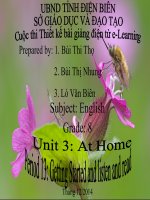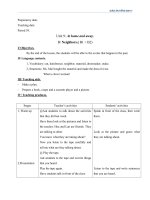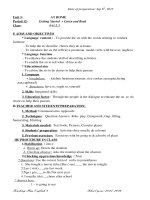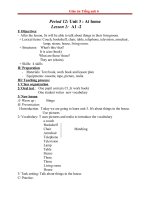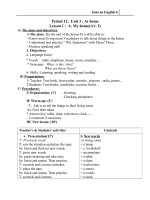Giáo án Tiếng Anh 8 Unit 3: At home
Bạn đang xem bản rút gọn của tài liệu. Xem và tải ngay bản đầy đủ của tài liệu tại đây (242.6 KB, 13 trang )
Tiếng Anh 8 – Giáo án
Unit 3: At home.
Period 12: Lesson 1:Getting started- Listen and read.
I. Objectives:
- After the lesson, Ss will be able to understand the dialogue and use model verbs
to talk about the housework.
II. Preparation:
- Textbook, cassette and tape. -Picture
III. Teaching procedure:
1. Organization:
2. Oral test:
- Homework correction.
3. New lesson:
A. Warm- up/ Getting started: Kim’s game:
- Show 6 pictures to Ss.
- Ask Ss to look at the pictures quickly in 30 seconds and try to remember the
verbs in the pictures as many as possible.
- Which team remembering more verbs is the winner.
* Answer:
a, wash dishes
d, cook
b, make the bed
e, tidy up
c, sweep the floor f, feed the chicken.
B. Presentation:
1. Pre- reading:
- Teach the new words:
a steammer (n): nồi hầm
chore(n): việc vặt trong nhà
a cup board (n): chạn bát đĩa
a sink (n): bồn rửa bát.
a sauce pan (n): xoong /nồi nấu canh. store (n): cái lò
rice cooker (n): nồi cơm điện
* Checking:What and where.
2. While- reading:
- Play the tape twice for Ss to practice listening.
- Ask Ss to practice reading the dialogue in pairs.
- Call some pairs to read aloud.
- Present the use of the model verbs.
- Give form:
Has/ Have to + infinitive = must + bare infinitive.
- Ask Ss to list the things Nam has to do.
- cook the dinner
Nam has to
- go to the market to buy fish and vegetables.
- call his aunt, Ms Chi and ask her to meet his mother at grandma’s
house.
3. Post- reading:
- Use the picture cues drill
a, do the washing up
d, cook
b, make the bed
e, tidy my room
c, sweep the floor
f, feed the chicken.
- Ask Ss to practice in pairs with example exchange:
S1: What do you have to do?
S2: I have to do the washing up.
- Call some pairs to practice.
4. Consolidation:
- Remind Ss the model verbs.
5. Homework:
- Review the key points.
- Prepare the next lesson: Speak.
Unit 3: At home.
Period 13: Lesson 2: Speak.
I. Objectives:
- After the lesson, Ss will be able to use the prepositions of place to talk about the
positions of furniture in the house.
II. Preparation:
- Textbook. -Picture
III. Teaching procedure:
1. Organization: 8A:...........
8B:...........
2. Oral test:
- Homework correction.
3. New lesson:
A. Warm- up: Kim’s game:
- Divide the class into 2 teams.
- Show the picture of the kitchen on p.28 to Ss.
- Ss look at the picture quickly in 30 seconds.
- Take away the picture and ask Ss to write down as many things as they can
remember. Which team having more things wins the game.
B. Presentation:
1. Pre- speaking:
- Ask Ss the positions of the items in the pictures.
Where is the clock?
Where is the fruit?
Where are the flowers?
Where is the rice cooker?
Where is the cupboard?
Where are the knives?
Where is the dish rack?
2. While- speaking:
It’s on the fridge
It’s in the bowl.
They are on the table.
It’s next to the bowl of fruit.
It’s on the wall, above the counter.
They are on the wall, under the cupboard
It’s on the counter, next to the bowl of fruit.
- Get Ss to work in pairs, talking about the position of each item.
E.g:
The calendar is on the wall, above the stove.
The knives are on the wall, under the cupboard, about the counter.
The sink is next to the store.
The knives are on the wall, under the cupboard.
The bowl of fruits is between the rice cooker and the dish rack.
The clock is on the wall, above the refrigerator.
The flowers are on the table.
- Ask Ss to look at the picture and talk about their ideas.
- Ask Ss to practice in pairs.
- Call some pairs to practice.
- Give some remarks.
4. Consolidation:
3. Post- speaking:
- Ask Ss to practice speaking:
+ If they agree, they may use:
OK.
You are right.
+ If they disagree, they may use:
No, I think we’d better/ ought to put........
I think it should be...........
- Check their anwser & give feedback.
Key: - Let’s put the clock on the wall, between the shelf and the picture.
- Ok. I think we ought to put th TV & the stereo on the shelf.
- I think the coffe table should be between the couch and the armchair.
- Let’s put the telephone next to the couch.
- I think we should put the magazine about the books on the shelf.
- I think the shelf ought to be at one of the corners, opposite the
couch.
5. Homework:
- Do the Ex in workbook.
- Prepare the next lesson: Listen.
Unit 3: At home.
Period 14: Lesson 3: Listen.
I. Objectives:
- After the lesson, Ss will be able to identify the right item by listening.
II. Preparation:
- Textbook, cassette and tape.
III. Teaching procedure:
1. Organization:
2. Oral test:
- Homework correction.
3. New lesson:
A. Warm- up: Bingo:
- Ask Ss to write down on their notebooks 5 things you can eat.
- Prepare a list of food. Then call out each word in a loud voice.
- Ss listen carefully. If anyone has the same things, they cross them out. The first S
crossing out all 5 things shout “bingo” and win the game.
* Suggested list of food: chickens, beef, cake, candy, noodles, garlic, bread, rice,....
B. Presentation:
* Pre- listening:
+ Predictions:
- Give 8 words of things in the picture to 8 Ss .Ask Ss to stick on the right things.
onion
steamer
garlic
rice
chicken
pan
noodl
e
pepper
ham
pe
a
- Get Ss to look at P.30 to guess 4 things they use to cook the “Special Chiness
Fried Rice’
* While- listening:
- Ss listen to the tape and check their predictions.
- Play the tape again for Ss to listen through.
- Call some Ss to give the answers.
- Give feedback:
a, Fried rice.
b, Pan
c, Garlic and green peppers
d, Ham and peas.
* Post- listening:
- Call some good Ss to give the recipy to cook the “Special Chiness Fried Rice’
4. Consolidation:
- Remind Ss some key techniques in practice listening to catch information.
5. Homework:
- Do the Ex in workbook.
- Prepare the next lesson.
Unit 3: At home.
Period 15: Lesson 4: Read.
I. Objectives:
- After the lesson, Ss will be able to understand the safety precautions in the house
and practice using Why - because.
II. Preparation:
- Textbook. cassette and tape.
III. Teaching procedure:
1. Organization:
2. Oral test:
- Homework correction.
3. New lesson:
A. Warm- up: Brainstorming:
Drug
Boiling water
Fire
B. Presentation:
* Pre- reading:
- Teach some new words:
electricy
Danger in the
home for
children
knife
gas
a precaution (n): sự đề phòng
a socket(n): æ cắm điện
a match (n) que diêm
an object (n) đồ vật
safety (n) sự an toàn
(to) destroy : huỷ diệt
(to) injure : bị thương
+ Checking: Slap the board.
- Ask Ss to read the statements and guess which is true, which is false.
- Give T/F statements prediction basing on the part in textbook.
* While- reading:
a. Reading the text.
- Ss read the text and check their prediction.
- Ask Ss to correct if the statements is false.
- Give feedback.
Key: a.F
b:T
c:F
d: F e:T
f:T
a.It’s safe to keep mechine in locked cupboards.
c.A kitchen is a dangerous to play.
d.Playing with one match can cause a fire.
b, Comprehension questions:
- Ask Ss to work in pairs to find out the answers of the given questions.
- Ask Ss to give their answers by both orlly and in writing.
- Give answers:
a. Because children often try to eat and drink them.
b. Because the kitchen is a dangerous place.
c. Because playing with one match can cause the fire.
d. Because children often try to put ST into electrical sockets and electricity
can kill.
e. Because the dangerous objects can injure or kill children.
4. Consolidation:
* Post - reading:
Discussion:
- Ask Ss to work in groups, discussing about the topic.
a. Safety precautions in the street.
b. Safety precautions at school.
5. Homework:
- Practice in Why questions with Because- answer .
Unit 3: At home.
Period 16: Lesson 5: Write.
I. Objectives:
- After the lesson, Ss will be able to write a description of a room in their house.
II. Preparation:
- Textbook.
III. Teaching procedure:
1. Organization:
2. Oral test:
- Homework correction.
3. New lesson:
A. Warm- up: Chatting:
- Ask Ss something about the room on P.32:
which room is this?
What’s this? Where is it?
B. Presentation:
* Pre- writing:
- teach some new words
folder (n): cặp đựng tài liệu
beneath ( pre) = under
towel rack (n): giá để treo khăn
dish rack(n): giá để bát đĩa
lighting fixture (n): đèn trùm
* Checking: R.O.R
- Ask Ss to read the description of Hoa’s room, then ask some comprehension
questions:
a. What is there on the left of the room?
There is a desk on the left of the room.
b. Where is the bookself?
It is above the desk.
c. What is there on the right side of the room?
There is a window.
d. Where is the wardrobe?
It is beside the window and opposite the desk.
* While- writing:
- Ask Ss to describe Hoa’s kitchen, using the given cues.
- Ss practice writing individually.
- Ask some Ss to give their own writing on the board while the others read it
aloud.
+ Answer:
This is Hoa’s kitchen. There is a refrigerator in the right corner of the room. Next
to the refrigerator are the stove and the oven. On the other side of the oven, there is
a sink and next to the sink is a towel rack. The dish rack stands on the counter, on
the right of the window and beneath the selves. On the selves and on the counter
beneath the window, there are jars of sugar, flour and tea. In the middle of the
kitchen, there is a table and four chairs. The lighting fixture is above the table, and
directly beneath the lighting fixture is a vase with flowers.
- Ask Ss to share and correct their own writing.
4. Consolidation:
* Post- writing:
- Ss talk about their partners about their room/ living room/ kitchen.
5. Homework:
- Ss write a description of their room or living room.
Period 17: Lesson 6: Language focus .
I. Objectives:
- Further practice on the reflexive pronouns, the modals and Why - Because. .
II. Preparation:
- Textbook.
III. Teaching procedure:
1. Organization: 8A:...........
8B:............
2. Oral test:
- Homework correction.
3. New lesson:
A. Warm- up: String:
- Give the word and ask Ss to form another word by taking the last letter of the
previous word.
Example: English - high - hello - on - ..............
B. Presentation:
a. The modals: have to / must:
- Ss read the dialogue between Nam and Mrs Vui again and find out the sentences
which contain the modal: have to.
- Revise the list of things Nam has to do.
- Give form: Has/ Have to + infinitive = must + infinitive.
- Give Ss 7 words : feed - empty - tidy - sweep - clean - dust - do.
- Ask Ss to look at the pictures and complete the dialogue between Nga and Lan.
- Ss practice in pairs.
- Give key: have to do - must tidy - have to dust - must sweep - have to clean must empty - must feed.
- Ss copy and practice reading again.
b, The modal: ought to:
- Set the scene: “ Hoa is very sad because she failed her English test. What do you
say to advise her? ”
- “You should study harder”
- another way: “You ought to study harder”
- Use: ought to as well as should is used to give advice to someone.
- Form: ought to + infinitive.
- Ask Ss to give advice to people in the pictures.
- Get Ss to give answers orally.
- Key: b. You ought to get up earlier.
c, You ought to eat more fruits and vegetable.
d, You ought to see the dentist.
c. The reflexive pronouns:
- Set the scene: You do your homework and noone helps you. What do you say?
I do my homework myself
- Form: We use
I
with
myself
you
yourself / yourselves
he
himself
she
herself
we
ourselves
they
themselves
it
itself
- Used to emphasize a person or a thing.
E.g: She cut herself
John saw himself in the mirror.
- Give Word Cues Drill.
d. Why - Because:
- Set the task, and ask Ss to revise the way to practice.
- Ask Ss to practice orally.
- Call some pairs to practice aloud.
- Correct and remark.
4. Consolidation:
- Remind Ss the key points.
5. Homework:
- Revise and do the Ex.

